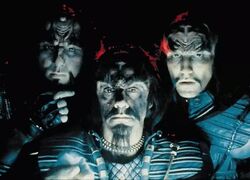
Klingons.
- "A Klingon's honor means more to him than his life!"
- ―Kurn
The Klingons (Klingonese: tlhIngan) are a humanoid warrior species that originated from the M-class planet of Qo'noS (pronounced Kronos). One of the major powers of the galaxy, the Klingons are a proud, tradition-bound people who value honor and combat. The aggressive Klingon culture has made them an interstellar military power to be respected and feared. Klingons believe that they have the instinctive ability to look an opponent in the eye and see any intent to kill.
Biology
The most distinctive feature of Klingon anatomy (except in those individuals afflicted with the Augment Virus) is a ridged forehead. The cranium is encased in an exoskeleton, which possesses a feature known as the tricipital lobe. (TNG: "Descent")
On average, Klingons are larger and physically stronger than Humans, though they possess much less tolerance for cold weather. (VOY: "Displaced"; DS9: "Change of Heart") Spock said once that Klingons lack tear ducts, however Klingon myth states that Kahless once filled the ocean with his tears. (Star Trek VI: The Undiscovered Country; TNG: "Birthright, Part II")

Klingon anatomy without the Augment virus
Internally, Klingon anatomy is markedly different from that of Humans. There is a great deal of redundancy in their organs, a principle they call brak'lul. This allows Klingons to survive severe injuries in battle. They have twenty three ribs, two livers, an eight-chambered heart, three lungs, and even redundant neural function and multiple stomachs. Some geneticists believe that the extra organs, notably the third lung, evolved to give Klingons greater stamina on the battlefield. Surprisingly, Klingons have relatively little knowledge of their own biology and their medicine is very poorly developed. This is largely due to their warrior traditions – a Klingon who is wounded is expected to be left to survive through his own strength, die, or to undergo the hegh'bat, a form of ritual suicide. (TNG: "Ethics"; VOY: "Lineage")
Klingon pregnancies normally run thirty weeks, but with mixed species, gestation times can be shorter. The odds against Klingon-Human conceptions are rather high; however, when successful, Klingon and Human metabolisms sometimes clash, causing biochemical fluctuations in the mother, which may lead to fainting. Klingon traits remain dominant for several generations, even with a single ancestor; therefore, a child even ¼ Klingon still possessed forehead ridges if he or she carries the gene. (VOY: "Lineage")
Klingons have ridged spines, chests and feet. (TNG: "Ethics"; DS9: "Sons of Mogh"; ENT: "Broken Bow") After birth some Klingon infants experience a pronounced curvature to the spine, which is correctable by surgery. This "defect" tends to run in Klingon families, especially among females. Federation medicine, fortunately, advanced beyond that, allowing an additional choice of treatment involving genetic modification. (VOY: "Lineage")

An unnamed evolutionary ancestor of the Klingon species
Klingon children mature far more quickly than Human children. At the age of only one Earth year, a Klingon child has the appearance a Human child has at about four. By the age of eight Earth years, a Klingon attains the maturity a Human doesn't reach until about age sixteen. (TNG: "Reunion"; DS9: "Sons and Daughters") When Klingon children begin growing into adults, they go through jak'tahla, a Klingon form of puberty. (Star Trek: Insurrection) Like other mammalian species, Klingon females are capable of lactating to breast-feed infants. (TNG: "A Matter Of Honor")
The average Klingon lifespan is over 150 years, but even into advanced old age, they tend to still be strong enough for combat. (DS9: "Blood Oath")
Evolution
The Klingon species has evolved from ancient predatory creatures possessing a thorny exoskeleton and venom-producing glands on the neck. (TNG: "Genesis")
History and Politics
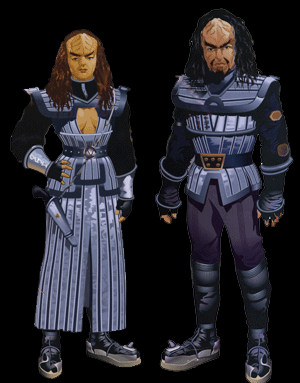
The Klingon Empire was founded some time in the 9th century by Kahless the Unforgettable, who performed many heroic feats including the unification of the Klingon people when he killed the tyrant Molor. Kahless came to be revered in Klingon society to the point of near-deification, and many aspects of Klingon culture came to revolve around emulation of Kahless's life. (TNG: "Rightful Heir")
The warrior ethos had been an important aspect of Klingon society since the time of Kahless, but the warrior aspects became much more dominant beginning in the early 22nd century. Previously, Klingon society was regarded as socially balanced, but over time the warrior caste gained greater prominence, to the point where the Klingons widely came to be regarded as a "warrior race." (ENT: "Broken Bow", "Judgment")
Because of their aggressive outlook, the Klingons generally had poor relations with other races after they began to move out into space. Because the worlds of the Klingon Empire were resource-poor, the Klingons developed an intense belief in the need for expansion and conquest in order to survive. The Klingons' relationship with Humans and the Federation was rocky at best. Following the disastrous first contact between Klingons and Humans, tense rivalries and unavoidable conflicts often developed between the two races. (TNG: "First Contact")
By 2223, relations between the Federation and the Klingon Empire degenerated to a point of unremitting hostility, which lasted for several decades. (Star Trek VI: "The Undiscovered Country"; TNG: "First Contact")
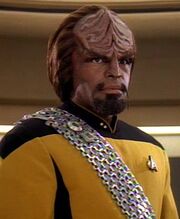
Worf, the first Klingon to join Starfleet
The lingering tensions between Klingons and Humans continued to rise, eventually leading to the Battle of Donatu V near Sherman's Planet in 2245, and later erupted into what was considered the first Federation-Klingon War in 2267. This war was quickly ended by intervention by the Organians after only four days of fighting. (TOS: "The Trouble with Tribbles", "Errand of Mercy") Over the next several decades, an uneasy peace developed that was broken by brief but fierce skirmishes and conflicts (Star Trek III: "The Search for Spock"; "Star Trek V: The Final Frontier"). A true and lasting peace finally came in 2293 with the signing of the Khitomer Accords, thanks to the efforts of Chancellor Gorkon and the Human Starfleet officer James T. Kirk. (Star Trek VI: "The Undiscovered Country") Since then, despite several periods of rocky relations (see Federation-Klingon War (2372-73)), the Federation and the Klingon Empire have been steadfast allies, especially in the face of Dominion aggression in the 2370s. (DS9: "By Inferno's Light")
The Klingon relationship with the Romulan people was also extremely unstable. A short-lived alliance and technology exchange notwithstanding, the Romulan Star Empire were typically regarded by the Klingons as a "blood enemy" since at least the 23rd century. Sporadic Romulan attacks against Klingon colonies (see Khitomer Massacre) and interference in Klingon affairs (see Klingon Civil War) continued to sour relationships between the two peoples. (TNG: "Sins of the Father", "Redemption II")
According to Daniels, the Klingons joined the Federation by the 26th century. (ENT: "Azati Prime")
Klingon Augments
In the year 2154, the Klingons gained access to the genetic material of Human Augments and tried to adapt this genetic engineering to improve themselves. An unanticipated side effect was that the Augment DNA caused the characteristic Klingon cranial ridges to dissolve.
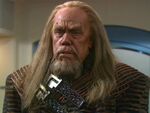
Dr. Antaak after losing his ridges from the Levodian flu.
The test subjects did gain increased strength and intelligence, but then their neural pathways started to degrade and they died in agony. One of the subjects suffered from the Levodian flu, which was modified by the Augment DNA to become a fatal, airborne, mutagenic plague that spread rampantly among the Empire, from world to world. In the first stage of this plague, Klingons lost the ridges on their foreheads and began to look more Human. With the help of a Klingon scientist named Antaak, Dr. Phlox of the Earth starship Enterprise (NX-01) was able to formulate a cure that halted the genetic effects of the virus in the first stage. This retained the changes in appearance along with some minor neural re-ordering. The neural ordering caused changes in the emotional make up of the Klingons. For example, the infected started to feel fear. Even though the infected did not develop any stage-two characteristics, such as enhanced strength, speed, or endurance they did not die from it. This left millions of Klingons changed. These alterations were even passed on to their children. (ENT: "Affliction", "Divergence")
It is possible that at first the treatment only gave many Klingons a single ridge from the bridge of the nose across the forehead, and then was eventually perfected and allowed a complete return to the original form. This speculation comes from the fact that many Klingons seen during the 23rd century possessed rather minor ridges (such as Chang, Korrd, and Azetbur). Of course this could be simply the differences in appearance between Klingon sub-races.
It has been suggested that the disease afflicting the Klingons seen in VOY: "Prophecy", Nehret, is the modified Levodian flu. The Doctor manages to cure the Nehret using stem cells from B'Elanna Torres daughter, who was ¾ Human and ¼ Klingon, suggesting a similar method was used to cure the Humaniform Klingons.Klingons were apparently so embarrassed by the fallout from their failed attempt at genetic enhancement that they refused to discuss the incident with outsiders. Due to the secrecy of the Klingon Empire, knowledge of the change became lost over time to the general population of the Federation. By the 24th century, the reason for smooth forehead Klingons was not widely known outside the Empire, and questions were generally met with a brusque answer along the lines of "we don't discuss it with outsiders." (ENT: "Affliction", "Divergence"; DS9: "Trials and Tribble-ations")
Mirror Universe
In the mirror universe, the Klingons were a founding race of the Klingon-Cardassian Alliance, where they formed an alliance with that universe's Cardassian counterparts. (DS9: "Crossover")
Culture and Society
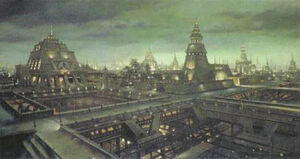
Qo'noS, homeworld of the Klingon species and Capitol of the Klingon Empire, is an M-class planet located in the Beta Quadrant of the Milky Way Galaxy
- "Even half drunk, Klingons are among the best warriors in the galaxy"
- ―The Doctor
Klingon society is extremely complex. Before its decline in the mid 22nd century and again in late 23rd century Klingon society was based on a feudal system organized around traditional Great Houses of noble lineage, to which various parts of the population owed fealty. The Great Houses are traditionally represented in the Klingon High Council, which is led by a Chancellor.
The decline of Klingon culture is demonstrated in the acts of the Klingons themselves. They stopped caring about their weapons to the point that they let them rust (ENT: "Marauders") and even stopped caring for true honor (ENT: "Judgment"). Sometime after the augment virus took hold of the Klingon Empire a new regime took control turning the Empire into a fascist state that kept tabs on all who served. (TOS: "Errand of Mercy"). The old ways returned in the latter half to the 23rd and the first part of the 24th century.
Males traditionally dominate public life in the Empire, assuming the leading roles in politics and the military with only rare exceptions. (TNG: "Redemption") A notable exception to the prohibition of women serving on the High Council came when Azetbur became Chancellor of the High Council after her father, Gorkon, was assassinated in 2293. (Star Trek VI: The Undiscovered Country) Women, in turn, traditionally dominate the household and the management of the family's affairs. (DS9: "You Are Cordially Invited") Klingon women are treated as equals except in politics and matters of inheritance. Klingon women are also just as capable as any male. They are prohibited by law from serving in the High Council and cannot take control of their Houses unless they have the money and no male successors of the lineage. Otherwise, Klingon women were expected to exhibit the same physical prowess and lust for blood and honor as the men. A true Klingon woman is neither Barbie nor a slave, especially not just because the other person is a man.
Klingon society functions through a system of family reputation and honor. Tradition is an integral part of their lives and breaking from observances is considered a grievous insult to society, an insult that is not forgotten easily. An offense usually brings shame to the offender's name for several generations. Bloodlines and relations are also taken very seriously by any "true" Klingon. Lines comprise of more than mere family members. (TNG: "New Ground")
An integral part of tradition is the various rituals that mark milestones in a Klingon's life or the history of the Empire. Most notable of the rites is the Rite of Succession, which a future leader of the Empire must complete with a valid Arbiter of Succession (Captain Jean-Luc Picard in the case of Gowron) overseeing the proceedings. Before the Rite can begin, there is another elaborate ceremony needed to confirm the death of the previous leader. This is known as the Sonchi ceremony. (TNG: "Reunion") Individual Klingon warriors are expected to go through the Rite of Ascension to be recognized as a full adult. (TNG: "The Icarus Factor")
Klingons are extremely territorial. According to the first known Klingon linguist, there was no such thing as an "insignificant corner of Klingon space". (ENT: "Bounty")
Ritual and Tradition
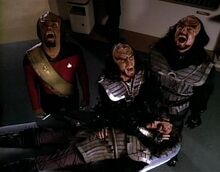
Klingon Death Ritual
Ritual is a very important element in Klingon society. While the Klingons are not a religious people as such, they do believe that deities existed at one time. However, Klingon warriors supposedly slew their gods as they were considered to be more trouble than they were worth. (DS9: "Homefront") They believe that once a Klingon dies, the spirit exits the body, leaving behind a worthless shell to be disposed of. (VOY: "Emanations") In the Klingon death ritual, it is traditional for those on hand to howl into the sky as a warning to the afterlife that a Klingon warrior is about to arrive. (TNG: "Heart of Glory"; DS9: "Tears of the Prophets") In some cases a funeral dirge is sung in memory of the deceased, or friends sit with the body to protect it from predators, a practice known as ak'voh. (DS9: "The Ship")
Furthermore, a Klingon who is unable to fight, and hence is unable to live as a warrior anymore, has the traditional obligation of committing the hegh'bat; the Klingon ritual suicide. Tradition dictates that the eldest son or a close personal friend must assist. That person's role is to hand the dying Klingon a knife so that he can plunge it into his heart, remove it, and then wipe the blood on his own sleeve. (TNG: "Ethics")

Gates of Gre'thor
The Klingon afterlife is supposedly divided into two branches. The dishonored are taken to Gre'thor aboard the Barge of the Dead, a vessel captained by Kortar, the first Klingon. Kortar was supposedly the one who had originally killed the gods who created him and was condemned to ferry the dishonored to Gre'thor as a punishment. Once in Gre'thor, the dishonored are watched over by Fek'lhr, a vaguely Klingon-esque figure. While it may be tempting to view Fek'lhr as the Klingon equivalent of the Human devil, according to Kang, the Klingons have no devil. (TNG: "Devil's Due"; VOY: "Barge of the Dead"; TOS: "Day of the Dove")
Those who die honorably supposedly go to Sto-vo-kor, where Kahless is said to await them. However, should a noble warrior die in a manner that might not merit a place in Sto-vo-kor, such as being assassinated in a surprise attack, he may still earn a place if others dedicate a great battle to his name, thus showing that he has earned respect among the living. (TNG: "Heart of Glory", "Rightful Heir"; VOY: "Barge of the Dead"; DS9: "Shadows and Symbols")
Klingon rituals include the R'uustai, a bonding ceremony which joins two people together in a relationship similar to brotherhood. (TNG: "The Bonding") Klingon tradition holds that "the son of a Klingon is a man the day he can first hold a blade." (TNG: "New Ground")
If a Klingon warrior struck another Klingon with the back of his hand, it is interpreted as a challenge to the death. Klingon warriors speak proudly to each other; they do not whisper or keep their distance. Standing far away or whispering are considered insults in Klingon society. (DS9: "Apocalypse Rising")
When going into battle, Klingon warriors often sing the traditional warriors' anthem, which is essentially an invocation to Kahless and a pledge to win a good death in battle. (DS9: "Soldiers of the Empire")
When choosing a mate, it is traditional for a female Klingon to bite the male's face, allowing her to taste his blood and get his scent. (VOY: "Blood Fever") Klingon daughters traditionally are given a piece of jewelry called a jinaq when they become old enough to select a mate. (TNG: "Birthright, Part II")
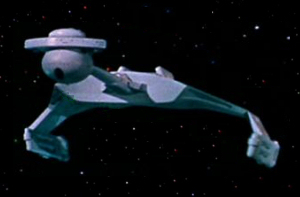
A Klingon D7-class battleship, used by the Klingon Empire during the 23rd century
References
Most of the information on this article comes from Memory Alpha, the Star Trek Wiki which is licensed under Creative Commons BY-NC 2.5 for noncommercial use.